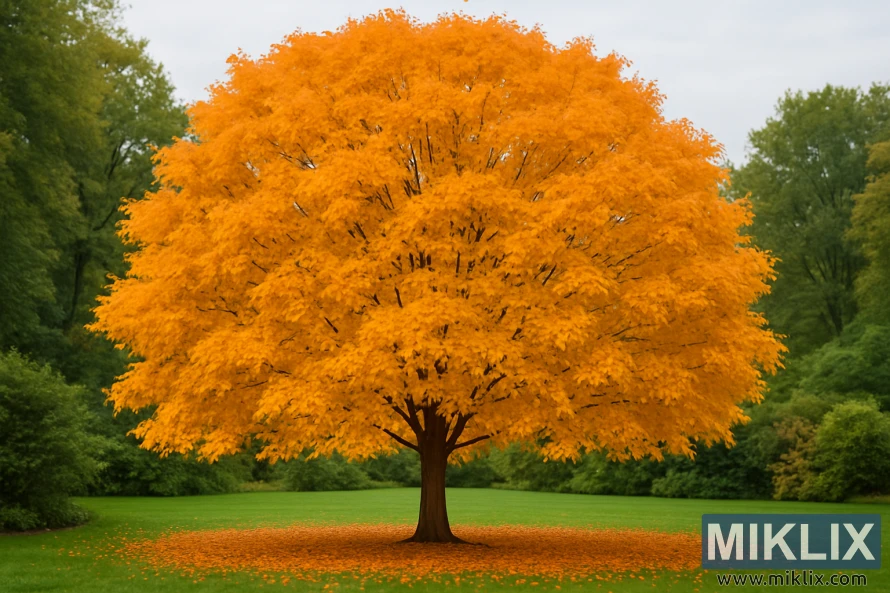Image: Sugar Maple in Autumn
Published: August 22, 2025 at 9:07:54 AM UTC
Last updated: September 28, 2025 at 8:22:28 AM UTC
A grand Sugar Maple with a dome-shaped canopy glows in golden-orange autumn foliage, its fallen leaves carpeting the green lawn below.
At the heart of this serene and carefully composed landscape stands a magnificent Sugar Maple (Acer saccharum), radiating the full splendor of autumn in a golden-orange blaze. Its broad canopy spreads outward in a nearly symmetrical dome, each branch adorned with countless leaves that shimmer in warm, sunlit tones. The brilliance of the foliage seems to set the entire tree aglow, as though it were lit from within, its crown a beacon of seasonal transformation. Each leaf, with its distinct lobes and serrated edges, contributes to the dazzling effect, combining to form a continuous expanse of fiery hues. The effect is both grand and intimate, a spectacle of color that captures the fleeting beauty of fall at its peak.
The sturdy trunk rises confidently from the ground, its bark marked by subtle ridges and textures that speak of strength and resilience. This central pillar anchors the otherwise ethereal display, providing balance and grounding to the vibrant canopy above. The branches, though mostly hidden beneath the dense foliage, spread evenly to support the dome-shaped crown, a natural architecture that reflects both grace and endurance. Beneath the tree, a soft carpet of freshly fallen leaves has begun to gather, forming a vivid ring of gold around the base. These scattered leaves echo the brilliance overhead, extending the maple’s presence into the lawn and reminding the viewer of the cycle of change that defines the season.
The surrounding garden plays a quiet yet essential role in enhancing the maple’s radiance. The lush, deep green lawn stretches out in every direction, serving as a tranquil canvas that highlights the fiery tones of the tree. In the background, layers of greenery—darker trees and shrubs softened by distance—provide depth and contrast, ensuring the maple remains the central focus of the scene. This interplay of colors and textures creates a sense of harmony, as though the entire setting were carefully arranged to celebrate the tree’s autumnal glory. The muted tones of the background keep the composition balanced, allowing the maple’s display to dazzle without distraction.
The light that bathes the scene is soft and even, diffused through a gentle sky that avoids the harshness of direct sun. This creates an atmosphere of calm and reflection, where the brilliance of the leaves is accentuated without being overwhelming. Every shade of golden-orange is captured in detail, from the deeper amber tones near the inner branches to the brighter highlights that catch the outer edges of the canopy. The overall effect is almost painterly, as if the scene were designed to convey both the grandeur and the quiet beauty of the season. The absence of harsh shadows adds to the tranquility, allowing the viewer to take in the full splendor of the Sugar Maple’s autumn attire.
This image embodies why the Sugar Maple is considered one of the most cherished trees for gardens and landscapes. Beyond its aesthetic magnificence, it symbolizes the essence of autumn itself: a season of change, beauty, and fleeting brilliance. Its golden crown stands not only as an ornament in the garden but as a living monument to the passage of time, a reminder that each season brings its own form of wonder. In this moment, the Sugar Maple commands admiration, its dome of fiery foliage transforming a simple stretch of lawn into a place of awe and contemplation. It is both a centerpiece and a symbol, representing the enduring bond between nature’s cycles and human appreciation of beauty.
The image is related to: The Best Maple Trees to Plant in Your Garden: A Guide to Species Selection

